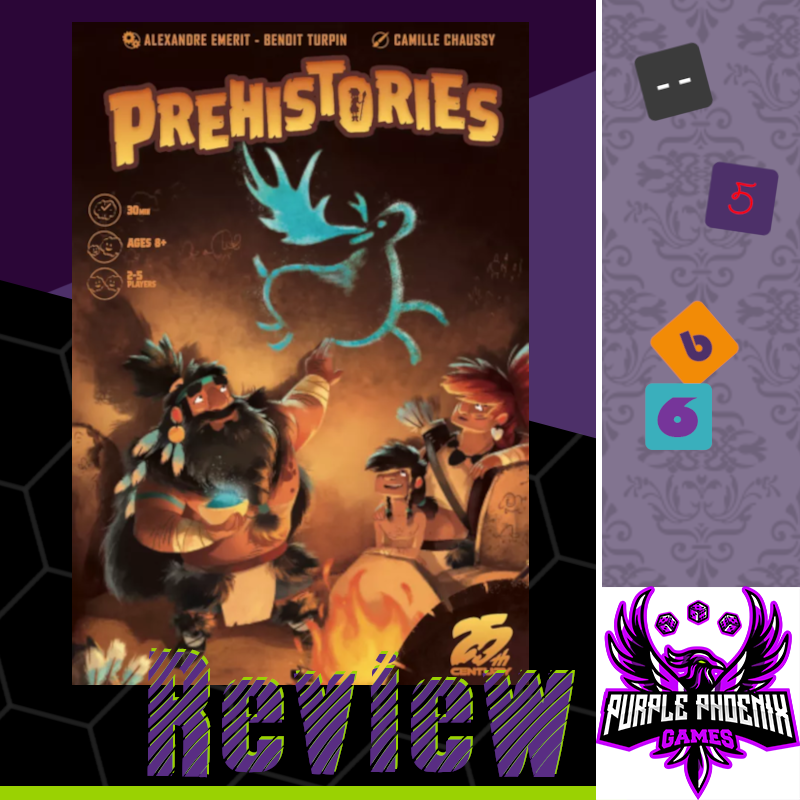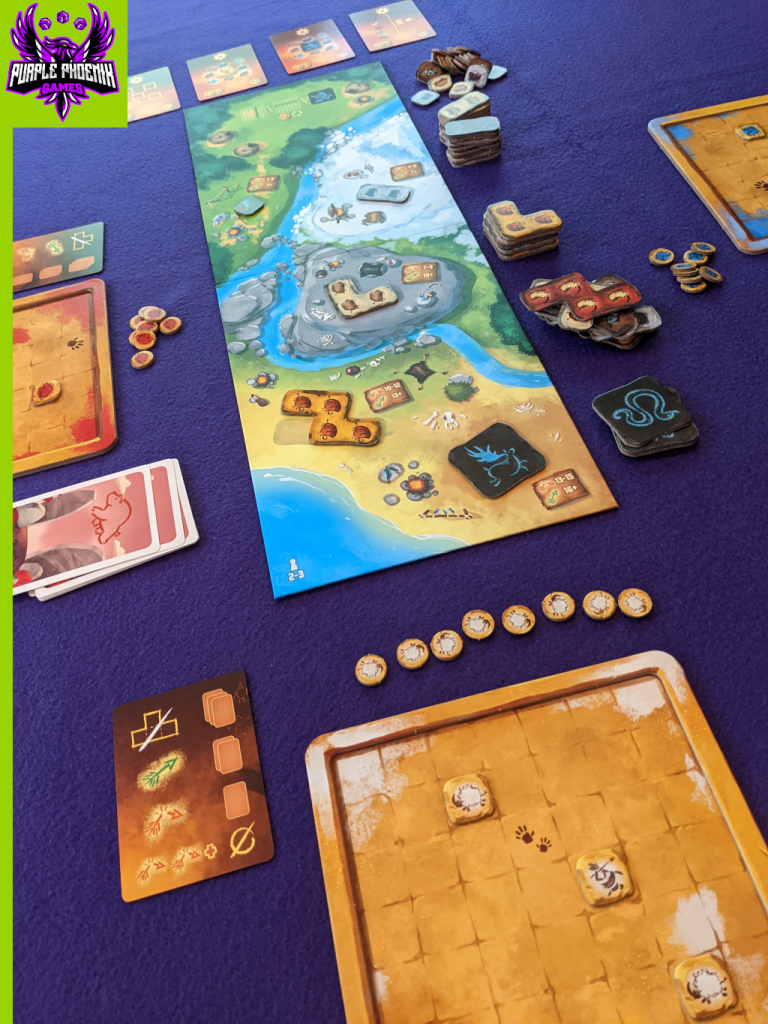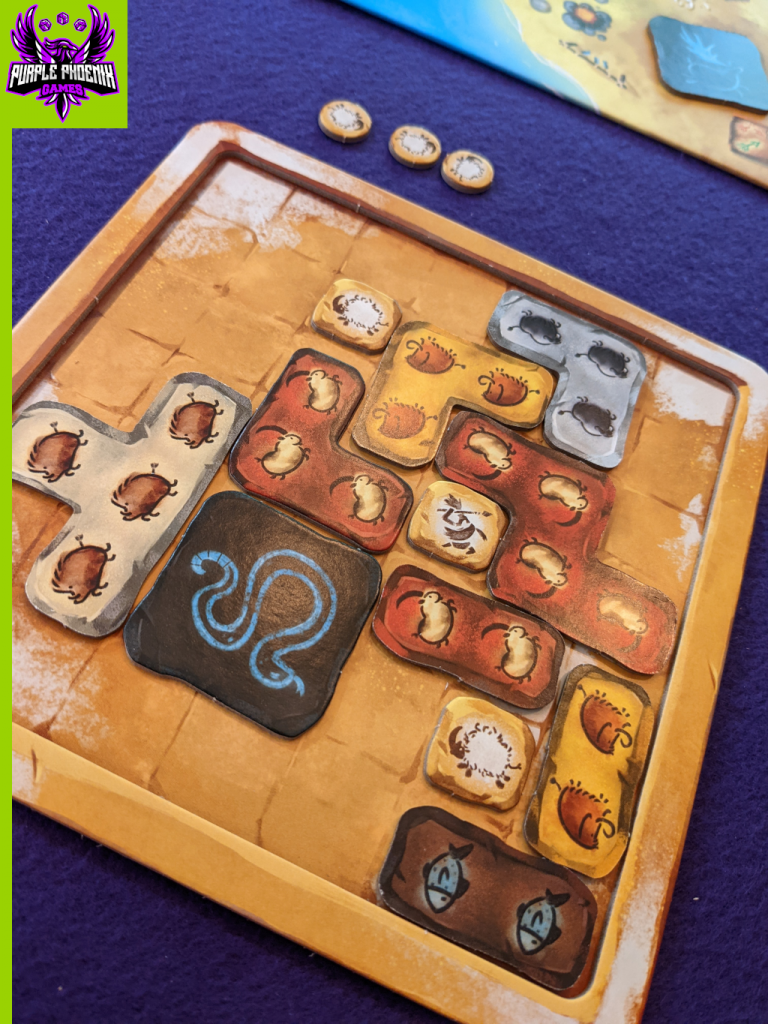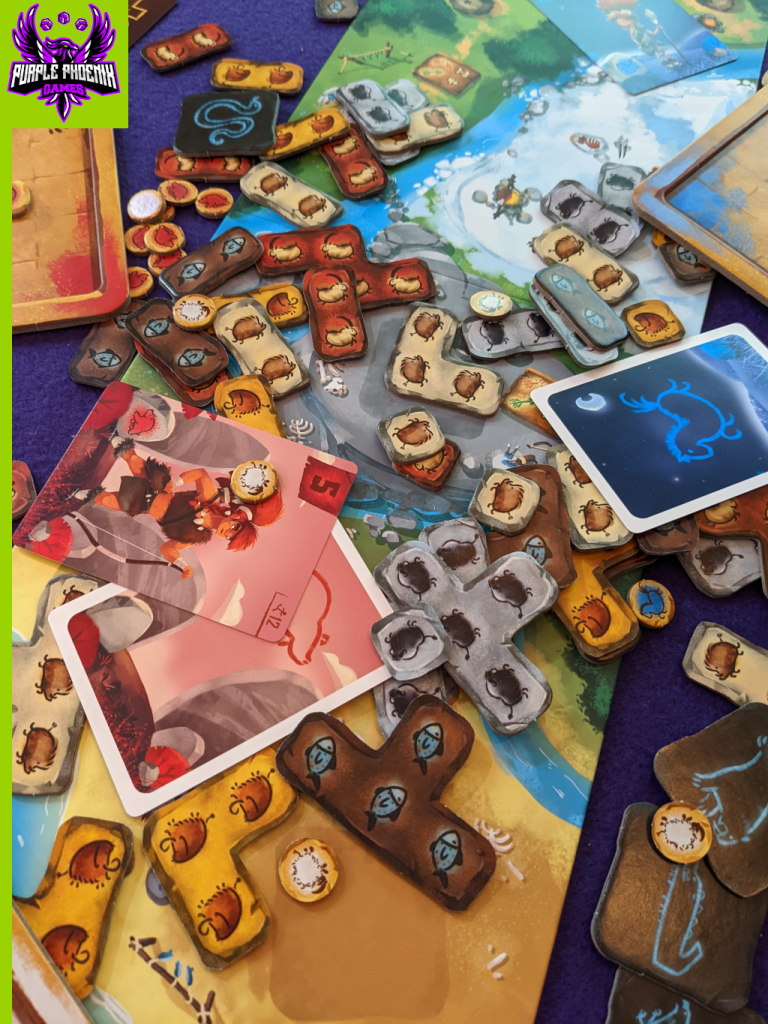
All throughout time there have been bosses and underlings. The bosses are in charge and make decisions while the underlings perform tasks in support of those decisions. It works this way in modern offices, with bees in the hive, and apparently also with ancient cave-dwellers and their clan Elders. Prehistories is a retelling of these bosses and their underlings, but with way nicer components.
| Prehistories (2020) | 25th Century Games |
| 2-5 Players | 30 minutes |
| Ages 8+ | BGG Weight – 1.80 / 5 |
Prehistories is actually a pattern building, tile placement, and auction game for two to five cavepeople. Cavepersons? These cavers will be sending out their hunters to bring back sets of like animal species from which middle management will decorate the caves with their likenesses. The winner will be the cavefolk who are able to claim victory and place their eight totems upon the board.
DISCLAIMER: We were provided a copy of this game for the purposes of this review. This is a retail copy of the game, so what you see in these photos is exactly what would be received in your box. I do not intend to cover every single rule included in the rulebook, but will describe the overall game flow and major rule set so that our readers may get a sense of how the game plays. For more in depth rules, you may purchase a copy online or from your FLGS. -T
To setup players choose a color and takes all the components of matching color: Hunter cards, Totems, Cave board, and a player aid card (if needed). Players shuffle their deck of 12 cards and draw three for their opening hand. The main board is placed between all players and populated with appropriately-matching Animal tiles, as seen below. The board side and number of Objective cards placed are dependent on the number of players – the photos below are for a three-cave clan game. The players are ready, the board is set, and the time machine brings the players back to the time before so the game may now begin! Cue the Huey Lewis! Strike the DeLorean.

Prehistories is played in rounds consisting of four main phases: Round Setup, Planning Phase, Hunting Phase, and Painting Phase. During the Round Setup phase, the board will be repopulated with one animal tile per space, if tiles still exist for each size; these are Tetrisoidal polyominoes (man, that makes me feel so smart) in differing shapes featuring each of the animal types to be hunted.
Once the board is populated players begin the Planning Phase by choosing cards from their hand they wish to bid for turn order. They place these face-down in front of themselves until every player is ready and they all reveal their cards simultaneously. The player with the lowest value (colored number in the upper left corner) worth of cards is fastest and will have the opportunity to hunt first in the next phase. Sometimes even playing multiple cards may still result in the lowest value and secure the first opportunity.
When the play order is set, the first player for the phase will take their turn during this Hunting Phase by selecting tiles from the board. Using the total value of their cards, the active player decides which, if any, animal tiles they wish to hunt (victory is automatic). They select which of their cards used in the previous phase to use for their value and choose a tile to remove. Each hunting zone on the board has a printed cost range that will inform the player whether their hunt was an overwhelming success, or if hunters suffer any sort of injury. Injuries affect the number of cards to be drawn next, with more injuries resulting in fewer cards drawn. If a player decided not to hunt at all, they may draw three cards, a player completing a successful non-injured hunt may draw two cards, and one card is drawn if a hunting party suffered an injury, but no cards are drawn if the party suffered more than one injury. For example, the hunting party consists of two hunters with a value of 1 and 2. As this totals 3, if this player chooses to take the 1-square small tile they will suffer one injury, as this hunting zone requires a hunting party worth a value of 4 or more to suffer no injuries.
Once all players have drawn the appropriate number of cards, they may initiate the Painting Phase. During this phase players will place their newly-won animal tiles upon their cave board. As shown in the photo below, tiles may be made of different animal species, and certainly of different shapes and sizes. One very important rule when placing tiles is that all animals painted MUST be facing the same direction. This means that all animals will be shown with their feet pointing down to the same edge of the cave board as if they are all running on the same flat surface. Obviously, I forgot that rule when I first played the game and the photo below shows that rule broken. Do as I say, not as I do, folks.
With the animal tiles now painted on the cave walls, the player will check the objective cards placed during setup for any satisfied conditions. These cards are paramount as they offer benefits for cavers who complete the challenges first by allowing them to place multiple Totems upon the card. These cards’ challenges include painting five size-1 animal tiles, completely surrounding the Hunter that comes pre-painted in the player’s cave, and even painting all four corners of the cave with animal tiles. Each time these are completed, players may add Totems from their pool to the card and inch closer to victory. Remember, a player wins once they have placed all eight of their Totems. The main board also provides a couple objectives that can be scored multiple times for Totem placement. At the moment a player places their eighth Totem the game is over and that player wins! Each other player must then cook the winner a steak in honor of their victory. Well, at least that’s how I enjoy victory.

Components. I have become such a big fan of 25th Century Games and what they cram into their boxes. This one is definitely no different as everything here is super great quality. The individual cave boards are different for each player, with raised spaces to indicate the central Hunter and two animal tiles already given. All of the animal tiles are easy to distinguish and are thematically (but purposely) imperfect. It is so easy to get into the theme of this game, especially when the art style and overall aesthetic is just so darn perfect. I have played other prehistory hunting party themed games, but Prehistories sits on top as the most thematically interesting for me.
Okay so sure, it looks great, but if I only enjoyed games because they look great I probably wouldn’t be playing many games. However, Prehistories was a big surprise for me when I started playing it. Obviously I got a few rules wrong the first time I played (I mean check out these photos), but each time I have played it, I have been given a gift of a really excellent time with friends and family. Double-thinking my opponents on the bid for turn order, then grabbing an unexpected tile or two just to foil their plans just never gets old.
I really enjoy when games are infinitely replayable, and though I don’t necessarily feel Prehistories fits that bill, it certainly has a large amount of replability. It ships with five different cave boards and nine double-sided Objective cards. Add these to a party of unpredictable playmates and you have a recipe for some great times where each game will feel completely different. I like that. A lot. I am not the only one who enjoys this, as seen by our ratings graphic up top. Purple Phoenix Games (and my wife) gives this one a solid 17 / 18. If I can get Laura to play it a few more times with different players I’m sure she would increase her score. Here’s to accepting that challenge, and to another great game by one of my favorite publishers. Consider grabbing this one while you can. It’s fantastic!

